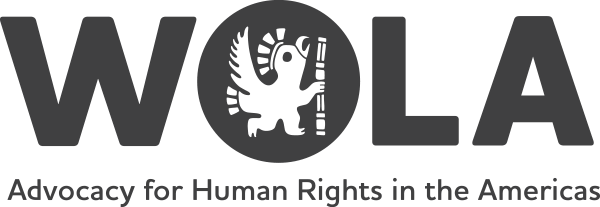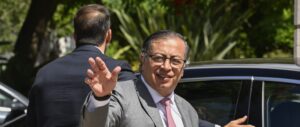WOLA colleague and dear friend, Javier Diez Canseco, died one year ago on May 4, 2013. Javier was Peru’s leading leftwing politician. He served in both chambers of Congress from 1978 until 1992 (when Congress was dissolved following the “self-coup” by President Alberto Fujimori), from 2001 to 2006, returning to Congress once again in 2011. On the one year anniversary of his untimely death, WOLA Senior Fellow Coletta Youngers reflects on Javier’s life and his impact in Washington, D.C.
When I look back at the time Javier spent in Washington, two images come to mind. The first is Javier sitting in my living room, laughing and engaging with my kids. In my family, everyone calls Javier Blackbeard. That is because once when he was staying with us – it must have been 1994 o 1995 as my son Jeremy was 2 or 3 at the time – Jeremy wobbled in, took one look at Javier, pointed to his chin and said, “blackbeard,” at which point Javier’s laughter filled the room. From then on, we always called him by that nickname (no pirate pun intended!), even after the black began to turn to a distinguished gray.
A few years later, when my kids began to understand that one of Peru’s most important political leaders would stay with us when visiting Washington, they would remark that he seemed so “normal.” Javier was indeed normal in the sense of relating to everyone with a big heart, humor and thoughtfulness – taking my kids as seriously as he would have done with any big-name politician. Yet he was far from normal when it came to his intense commitment to human rights, socioeconomic justice and the right for people to have a say in how their country is governed. And he was far from normal in his ability to translate that commitment into effective action, even in faraway places like Washington.
The second image that comes to mind is that of Javier walking down the halls of the U.S. Senate, where he was often in route to the office of Senator Patrick Leahy, who over many years has been one of staunchest defenders of promoting human rights and democracy in Peru. Following Fujimori’s 1992 autogolpe, opposition politicians from across the political spectrum began appearing regularly in my WOLA office. I often thought it strange that they would seek me out, despite my known progressive views, until I realized that very few Peruvian politicians who had not served in the executive branch had contacts in Washington and I was known for working on Peru; hence, they tended to come to WOLA regardless of their political views to get oriented to the ways of Washington. That was not the case, however, with Peru’s most prominent left-wing politician as by then Javier was a well-known figure in the U.S. capital.
Javier’s work in Washington began back in the mid-1980s. Nobody in Washington had heard of Ayacucho, the massacres taking place there or of the Shining Path until Javier came seeking international support in denouncing the human rights atrocities that were being ignored in Lima. My predecessor at WOLA, George Rogers, remembers that “Javier was the one who came up here and, given this political profile, was able to open up doors” and create space for working on Peru. George recalls organizing lunchtime seminars where Javier would speak, providing insightful analysis and concrete information that allowed human rights activists in the United States to become engaged in international advocacy on Peru. He would take Javier from congressional office to congressional office to explain what was going on in his country, generating letters and other forms of support from key U.S. representatives and senators. Perhaps most importantly, he began sensitizing U.S. politicians to the situation in Peru before the Fujimori regime, ensuring a swift response from the U.S. Congress once Peru began down that dictatorial path.
Other human rights activists followed Javier to Washington: Pancho Soberón (APRODEH), Patricia Valdez (CEAS), Pablo Rojas (COMISEDH) and Diego García Sayán (Comisión Andina de Juristas) come to mind. But in the mid-to-late 1980s, Javier was the face of Peruvian human rights activism. The congressional investigations he led into massacres such as Accomarca and Cayara further enhanced his credibility. I was always struck by how one day Javier could be interacting with the people of a village where some awful event had occurred and days later, he could calmly and concisely explain to a group of congressional aides why they needed to be paying attention to Peru and what they should be doing about it. Javier was uniquely suited to being able to operate effectively in both worlds, without ever losing sight of his ultimate objective, which was to defend those who were least able to defend themselves, those who had been abandoned by the State and those who were caught between two brutal forces of violence.
Perhaps of greatest significance, he was able to convey a sense of commitment and urgency to people thousands of miles away from what was going on in Peru. Many people on Capitol Hill become enamored with the power of their office and can be abrupt and even rude in the 15 or 20 minutes of their time that they grant to such visitors. Javier had a special capacity to reach even those individuals on a human level.
I will never forget the phone call I received in November 1990 (Fujimori had been in office only a few months) about the bomb that had gone off at Javier and Liliana’s house – one of the first atrocities carried out by the Colina death squad. But because Javier was known in Washington, we were quickly able to mobilize calls from congressional offices to the U.S. Embassy in Peru, encouraging the ambassador to make clear to Peruvian authorities his concern about what happened and for Javier’s well-being.
By the time of the autogolpe Javier had well-established connections with the offices of Senators Patrick Leahy and Chris Dodd, as well as numerous congressional representatives. Doors were already opened for him while other Peruvian politicians were still trying to figure out what doors they should be knocking on.
When the Clinton Administration took office in January 1993, there was a more propitious climate for engaging U.S. policymakers on Peru and other issues. The Clinton Administration played an important role in denouncing human rights abuses in Peru, supporting the Peruvian human rights community and over the course of the 1990s, pressuring the Fujimori dictatorship to return to a democratic path. (At the same time, of course, the CIA and other U.S. anti-drug officials supported Vladimiro Montesinos; U.S. foreign policy is often characterized by such contradictions.) For example, some officials would make a political point by visiting human rights groups before Peruvian government officials when in Lima. The U.S. State Department expressed concern at the 1995 amnesty law and other such dictatorial actions. And, as a result of advocacy efforts in Washington, in the mid-1990s the U.S. government cut off aid to the SIN, though we did not know that until later.
While by this time many Peruvians were engaged in advocacy work in Washington – with the Coordinadora Nacional de Derechos Humanos playing a particularly important role – their work was greatly facilitated by the path that Javier had forged before them. Or rather, Blackbeard.

